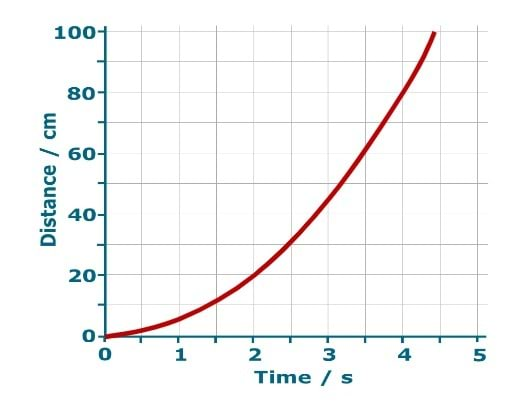Learning focus: | A resultant force on an object can cause it to speed up or slow down, depending on the direction of the force. |
Observable learning outcome: | Describe how quickly the speed of an object can be changed if acted on by resultant forces of different size. Describe how the speed of an object changes throughout the time that a resultant force is acting on it. |
Activity type: | Predict, explain; observe, explain (PEOE) |
Key words: | Distance-time graph, dynamics trolley |
Children below the age of about 11 tend to think of speed change as a short intensive effort, followed by constant speed. In a study (Hast and Howe, 2013), children observed a ball falling in free fall, accelerating down a ramp and rolling along a flat surface. In each case they were asked to predict whether the ball was speeding up, slowing down or travelling at a steady speed through the second half of each motion. For the accelerating balls the thirty-six 11-year-olds involved in the study made correct predictions only a little more often than they would have done by chance.
In a study by Dykstra and Sweet (2009) of 9- to 13-year-olds in the United States (n=103), it was found that the majority of students (aged 11-12) described the motion of an object as a snapshot of its direction and speed (moving quickly this way or slowly that way). Just 11% of this group gave a dynamic description of an accelerating object, in free fall or rolling down a ramp, in terms of a changing speed.
This activity challenges students’ misunderstanding by plotting a real-time distance-time graph that shows how a trolley accelerates throughout all of the time that a resulting force is acting on it.
Students should complete this activity in pairs or small groups, and the focus should be on the discussions. It is through the discussions that students can check their understanding and rehearse their explanations.
To begin, each group should discuss the activity and use their scientific understanding, firstly to predict what they think will happen, and then to explain why they think they are going to be right. If students in any group cannot agree, you may be able to direct them with some careful questioning.
Students now watch a demonstration and make a sketch of the graph that is produced. If you have enough sets of motion sensors and data-loggers, this may be carried out as a class practical. After the practical each group should be given the opportunity to change or improve their explanation. A good way to review your students’ thinking might be through a structured class discussion. You could ask several groups for their explanations and put these on the whiteboard. Then ask other groups to suggest which explanation is the most accurate and the most clearly expressed, and through careful questioning work up a clear ‘class explanation’.
A useful follow up is for individual students to then write down explanations in their own words – without reference to the class explanation on the board (i.e. cover it up).
Differentiation
The quality of the discussions can be improved with a careful selection of groups; or by allocating specific roles to students in the each group. For example, you may choose to select a student with strong prior knowledge as a scribe, and forbid them from contributing any of their own answers. They may question the others and only write down what they have been told. This strategy encourages contributions from more members of each group.
Equipment
For the class:
- Dynamics trolley
- Bench pulley
- Mass hanger (100g in total)
- Strong thread
- Drawing pin (or other means of attaching thread to trolley)
- Motion sensor and connecting lead
- Connection to a projector via a computer to plot distance-time graphs in real time or a data-logger
Technician notes
A wide variety of motion sensors are available and each type needs to be tested in order that settings are adjusted to obtain the best results.
A mass should be selected that overcomes friction forces and accelerates the trolley over a period of a few seconds.
It can sometimes help the motion sensor to detect the position of a trolley if a flat piece of cardboard is taped to the front of each trolley.
Health and safety
If this activity is carried out as a class practical there is likely to be a significant amount of movement during the activity. Dynamics trolleys can easily be damaged if they fall onto the floor.
Practical work should be carried out in accordance with local health and safety requirements, guidance from manufacturers and suppliers, and guidance available from CLEAPSS.
Dykstra, D. and Sweet, D. (2009). Conceptual development about motion and force in elementary and middle school students. American Journal of Physics, 77:5, 468-476.
Hast, M. and Howe, C. (2013). The Development of Children's Understanding of Speed Change: A Contributing Factor Towards Commonsense Theories of Motion. Journal of Science Education and Technology, 22, 337-350.

